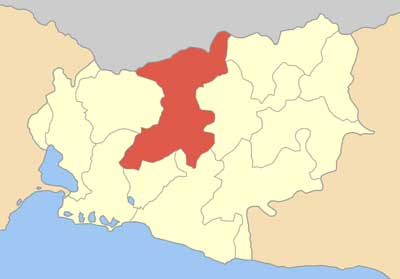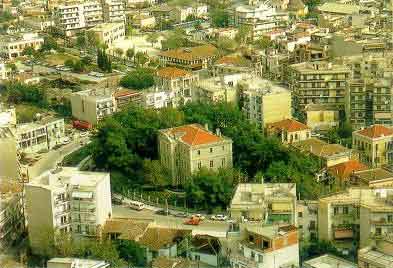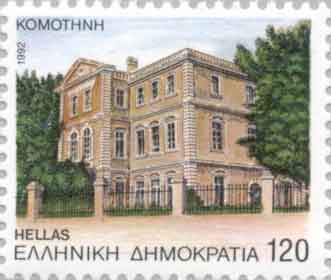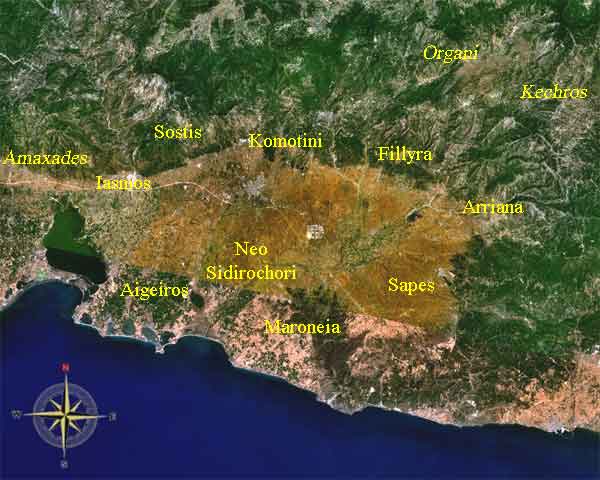.
Administrative Region : East Macedonia and Thrace
Regional unit : Rhodopi


Komotini (Greek: Κομοτηνή, Turkish: Gümülcine) is a city in Thrace, northeastern Greece. It is the capital of the periphery of East Macedonia and Thrace and of the Rhodope peripheral unit. It is also the administrative center of the Rhodope-Evros super-prefecture. The city is home to the Democritus University of Thrace, founded in 1973. Komotini is home to a sizeable Turkish-speaking minority, which constitutes 50% of the city's population.[1]

Geography
The city stands at an altitude of 32-38m on the Thracian plain near the foothills of the Rhodope Mountains. There is little urban planning in the older parts of city, in contrast to more recently developed quarters. According to the 2001 census, the municipality's population amounts to 61,501, a number that does not include approximately 13,000 resident students, trainees and soldiers. There are two airports near Komotini. The nearest is in Alexandroupoli (65 km), and the other is in Kavala (80 km). It has rail and bus links to all continental Greek cities as well as Istanbul, and the good provincial road network has been supplemented by the new Egnatia Odos motorway.
History
Antiquity
Komotini has existed as a settlement since the 2nd century AD. That is confirmed by archaeological finds of that era up until the 4th century. It is also confirmed by an inscription on the ruins of the 4th-century Byzantine wall, that are visible at various sites in the city, which reads "Theodosiou Ktisma" = Building of Theodosius. The inscription was discovered by the Komotini-born Prof. Stilponas Kyriakidis and the then mayor Sofocles Komninos. It is said that the township 'Komotini' originates from the 5th century and is linked to the daughter of the painter Parrasios from Maroneia. During the Roman age it was one of the several fortresses along the Via Egnatia highway which existed in the Thrace area. The most important city of that period was neighbouring Maximianopolis, former Thracian Porsulis or Paesoulae (which was renamed to Mosynopolis in the 9th century). Komotini was a Via Egnatia hub on its northern route through the Nymphaea Pass which lead to the Ardas Valley, Philippopolis (modern Plovdiv) and Byzantine Berroe (modern Stara Zagora).
Eastern Roman/Byzantine Era


View of the clock tower.
The city's history is closely connected with that of Via Egnatia, the Roman trunk road which connected Dyrrhachium with Constantinople. The Roman emperor Theodosius I built a small rectilinear fortress on the road at a junction with a route leading north across the Rhodope Mountains toward Philippopolis. During the Byzantine period, the city belonged to the Theme of Macedonia, whilst from the 9th century it could be found within the newly founded theme of Boleron. For most of its early existence the settlement was overshadowed by the larger town of Mosynopolis to the west, and by the end of the 12th century, the place had been completely abandoned. In 1207 following the destruction of Mosynopolis by the Bulgarian tsar Kaloyan, the remnant population fled and established themselves within the walls of the abandoned fortress. Since then the population had been increasing continuously until it became an important town within the area. In 1331 John Kantakouzenos referred to her as Koumoutzina in his account of the Byzantine civil war of 1321–1328.[2]. In 1332 Andronikos III Palaiologos set camp in Komotini to face Umur Bey of Smyrna at the Panagia village close to the Panagia Vathirryakos (Fatirgiaka) monastery. However, Umur departed without a battle. In 1341 the historian Nikephoros Phokas referred to the town with its current name. In 1343, during the civil war between John VI Kantakouzenos and John V Palaiologos, Komotini along with the neighbouring forts of Asomatos, Paradimi, Kranovouni and Stylario joined Kantakouzenos' side. John VI Kantakouzenos escaped to Komotini to survive from a battle with the army of the Bulgarian brigand Momchil near the already ruined Mosynopolis.
Ottoman Era
In the Ottoman Era, Komotini was known as Gümülcine or Ghumurdjina.[3] The city continued to be an important hub connecting the capital city of Constantinople with the European part of the Empire, and grew accordingly. Many monuments in the city today date to this era. In 1361, Gazi Evrenos conquered the town and thus a long period of Ottoman rule began. Many local families fled at that time to Epirus and founded the Koumoutzades village (modern Ammotopos, Arta). Even there they were persecuted and some of them found refuge in Tropaia of Gortynia. The bond between the inhabitants of Komotini, Ammotopos and Tropaia exists to this day. Komotini then belonged to the Edirne villayet and was the seat of the Komotini Kaza. After the end of the Ottoman rule, the town extended its boundaries beyond its walls. Komotini maintained its mostly Greek profile up to the end of the 16th century. In 1548 the French tourist Pierre Bellon stated that "the city is inhabited by Greeks and a few Muslims". Mass relocation of Uruks from the depths of Asia Minor and the islamisation of Pomaks were required to reinforce the Muslim population of the city. A Jewish community has also been described. During the Ottoman rule many armed insurgent Greek groups existed in the area, which forced Ahmed III to order their dissolution with poor results. During the Greek War of Independence Komotini's inhabitants contributed substantially with Ioannikios (later bishop), Aggelis Kirzalis and Captain Stavros Kobenos (members of the Filiki Eteria organisation). During the following decades Komotini progressed financially due to the processing and trade of tobacco. Greeks took advantage of the religious liberty granted by the Ottomans and completely controlled the economic activity of the city. The mansions that can be found today in the streets of Komotini (such as Stalios, Malliopoulos, Peidis) were built in that era. After the Russo-Turkish War of 1877–1878, a new wave of Muslim refugees arrived in Komotini. During that period the area found itself under Bulgarian pressure which originated in the rise of Bulgarian nationalism. In 1880 a Girls School and a Boys Urban School were functioning. In 1885 the cultural association 'Omonoia' was founded and it contributed in the cultural life of the city by presenting theatrical plays and concerts. Great benefactors such as Nestor Tsanaklis (builder of the Tsanakleios School, Dimitrios Sintos etc. rose during that era. Remarkable people that were born in Komotini include Alexandros Symeonidis (Professor of Medicine at the Aristotle University of Thessaloniki) and Victoria Margaritopoulou (one of the first Greek female doctors).
Jewish Community
The momument for the Holocaust.
Writings in the area of ancient Maroneia confirm the presence of Jews in the area. In the 16th century the Jewish community of Komotini consisted of Sephardite Jews who were textile and wool merchants. Many of the Jews had come to Komotini as immigrants from Edirne and Thessaloniki. The community was concentrated within the ancient walls of the city where the Synagogue was built in the 18th century. It was destroyed during WWII. In 1900 there were 1,200 Jews. In 1910 the Alliance Israelite Universelle School started functioning. Greek, French and Hebrew were taught in the school. In 1912–13 many Jews moved to larger cities such as Thessaloniki and Istanbul. After the liberation of Komotini (May 1920) the Israelite community of Komotini had a Cultural Club and Charity organisations. During the Bulgarian occupation, the Bulgarians (Nazi allies) arrested 863 [4] Jews and sent them to the concentration camp of Treblinka where they were exterminated (28 survived the Holocaust). In 1958 the Israelite community was dissolved due to lack of members. In 2004 the municipality of Komotini created a memorial (southern entrance of Central Park) for the victims of the Holocaust. [5] [6] [7] [8]
First Balkan War
Stamp from Komotini issued by the Greek military administration during the Second Balkan War (1913).
During the First Balkan War, Bulgarian forces captured the city, only to surrender it to the Greek army during the Second Balkan War on July 14, 1913. In this period, a short-lived independent state, the Provisional Government of Western Thrace, was established in Western Thrace. Komotini was declared as capital city of that state. The Treaty of Bucharest, however, handed the city back to Bulgaria. Despite various schemes by Greek inhabitants to avoid Bulgarian occupation, the city was part of Bulgaria until the end of World War I. During this period, the city had the Bulgarian name Гюмюрджина Gyumyurdzina. In 1919, in the Treaty of Neuilly, Komotini was handed back to Greece, along with the rest of Western Thrace.
Modern Komotini
Komotini is, nowadays, a thriving commercial and administrative centre. It is heavily centralised with the majority of commerce and services based around the historical core of the city. Getting around on foot is therefore very practical. However, traffic can be remarkably heavy due to the daily commute. In the past, a river used to divide Komotini into two parts. In the 1970s, after repeated flooding episodes it was eventually diverted and replaced by the main avenues of the city.
View of a central street.
Komotini main square.
Traditional street.
Heart of the City
At the heart of the city lie the evergreen Municipal Central Park and the 15 m-high WW2 Heroes' Memorial, locally known as 'The Sword'. The revamped Central square or Plateia Irinis (Square of Peace) is the focus of a vibrant nightlife boosted by the huge number of students living in the city. The Old commercial centre is very popular with tourists as it houses traditional shops and workshops that have long vanished from other Greek cities. In addition, in the northwestern outskirts of the city (Nea Mosinoupoli) locals and tourists alike flock into a modern shopping plaza: Kosmopolis Park, which houses department stores, shops, supermarkets, a cinema complex, cafés and restaurants. The area stretching from Kosmopolis to Ifaistos is gradually becoming a retail destination in its own right.
Culture and Entertainment
Komotini began life as a Byzantine Fortress built by the Emperor Theodosius in the 4th century AD. The ruins of this quadrangular structure can still be found NW of the central square. Komotini has several museums including the Archaeological, Byzantine and Folklore museums. SW of the central square one can find the Open-air Municipal Theatre, which hosts many cultural shows and events such as the cultural summer (πολιτιστικό καλοκαίρι = politistiko kalokairi). There is a Regional Theatre (DIPETHE) whose company produces many plays all year round. 6 km NE of Komotini is the Nymfaia forest. It has recreational facilities which comprise trails, courts, playgrounds and space for environmental studies. The forest is divided by a paved road which leads to the ruins of yet another Byzantine fortress and the historical (WWII) fort of Nymfaia.
Demographics
The population is quite multilingual for a city of its size and it is made up of local Greeks, Greek refugees from Asia Minor and East Thrace, Muslims of Turkish, Pomak and Romani origins, descendants of refugees who survived the Armenian Genocide, and recent refugees, including Pontic Greeks, from the countries of the former Soviet Union (mainly Georgia, Armenia, Russia and Kazakhstan).
Municipality
The municipality Komotini was formed at the 2011 local government reform by the merger of the following 3 former municipalities, that became municipal units:[9]
Aigeiros
Komotini
Neo Sidirochori
Quarters
Central
Historic Commercial Centre, Plaka, Armenio
West
Nea Mosinoupoli, Remvi
South-West
Kavakliotika, Stathmos, Ergatika Stathmou, Ergatika DEI
South
Zimvrakaki
South-East
Agios Stylianos
East
Neoktista
North
Agia Varvara/Stratones
Suburbs
Komotini Industrial Zone (SE, 9 km from City centre), with dozens of factories and an environmentally friendly natural gas-fuelled power plant.
Panepistimioupoli/Democritus University Campus (NW,3 km from City Centre) home of D.U.TH.
Ifaistos (NW,adjacent to Nea Mosinoupoli), home of a large Roma community
Roditis (SE,5 km from City Centre), residential area with upmarket properties
Karidia (NE,4 km from City Centre), residential area with upmarket properties
Kosmio (S,3 km from City Centre), residential area
Thrilorio (SE,8 km from City Centre), residential area
Ampelokipoi (SE,2 km from City Centre), residential area
Kikidio (SE,2 km from City Centre), mixed residential-business area
Ifantes (W, 2 km from City Centre), mixed residential-business area
Education
There are more than adequate primary and secondary education facilities in the city. There are around 20 primary schools, 7 gymnasia (junior high schools) and 4 lykeia (high schools) as well as the Institute for Vocational Training (IEK Komotini). In addition there is 2 technical education institutes (TEE).
Komotini is an established university city in the North of Greece known for its high standard of education and the unique and unforgettable 'Komotini student experience'. It is home to the Central Administration and several departments of the Democritus University of Thrace including the following:
Law School
Physical Education and Sport Sciences
History and Ethnology
Greek Literature
Social Administration
International Financial Relations and Development
Business Management (commencing in 2009)
Politics (commencing in 2009)
Languages, Literature and Civilization of Black Sea countries
The Komotini campus has a dynamic population of approximately 5–10.000 students and a major part of social life evolves around it. The founding of the University of Thrace in 1973 has had a significant positive influence on the entire urban area fuelling the city's expansion and growth.
The Police Academy is located 7 km from Komotini on the road to Xanthi on extensive grounds and with modern facilities.
Media
Television
The main television station based in Komotini is R Channel although other stations broadcast from the city, namely Delta from neighbouring Alexandroupoli and ET3 (the northern branch of the Hellenic Broadcasting Corporation) from Thessaloniki.
Radio
There are dozens of stations one can tune into. Some are broadcast from neighbouring towns and others are from Athens. The main Radio Stations broadcasting from Komotini are:
ERA Komotinis (part of the national ERA network, greatest coverage area in N. Greece)
Diavlos Rodopis
Hit FM
Radio Hronos
Radio Paratiritis
Radio Komotini
Isik FM
Radio City
Press
There has been increasing activity in this sector for the last 50 years. There are now 7 daily and 2 weekly active newspapers in the city.
O Hronos (The Time): Oldest, most popular, politics and news based content
Paratiritis tis Thrakis (Observer of Thrace): Multilingual (recognised with distinction by the President of The Hellenic Republic for its innovation) politics and culture.
To Elefthero Vima (Free Standpoint): Politics and culture.
Thrakiki Agora (Thracian Market): Weekly Politics and Financial news.
I Paremvasi (Intervention): Politics.
I Foni tis Rodopis (Voice of Rodopi): Politics.
Antifonitis (The Opposition): Reactionary Politics, satirical commentary.
Thrakiki Gi (Thracian Land): Politics and Agricultural News.
I Patrida (The Homeland): One of the oldest,Politics.
All of the above are paper based. However, there is an increasing volume of news and content that is on the newspapers' websites. The latter can be accessed from the news section of Komotini's commercial portal.[10]
Transportation
The railway station.
Komotini is a midland city and has no port. It is served by two airports. The nearest is in Alexandroupoli (65 km), and the other is in Kavala (80 km).
Highway Network
European route E90 runs through the city and connects Komotini with the other Greek Continental cities. The Egnatia Motorway (A2) lies south of the city. One can enter the city from one of two Junctions; 'Komotini West' and 'Komotini East'.
Public transit
There are a number of municipal buses serving 3 main lines within the city. The Intercity Bus Company of Komotini connects it to many local villages, the coastal areas and major Greek cities.
Railway
Hellenic Railways Organisation (OSE) trains run regularly at least twice daily westwards to Thessaloniki and Athens and eastwards to Evros and occasionally Istanbul.
Sports
The emblem of Panthrakikos F.C..
There is an impressive array of sports facilities available. They include the Komotini Municipal Stadium (Home of Panthrakikos FC), Panthrakiko Stadium (training grounds), Municipal Sports Complex (NE of the city), Municipal Swimming pool and Basketball Arena, Democritus University Sports Complex including an Arena and an Aquatic Centre as well as Basketball courts in almost every school in the city. The mountainous area in the north of the city is ideal for mountain-biking and trekking as well as 4x4 racing both of which take place throughout the year.
Panthrakikos F.C. – Football team, joined the Greek Superleague during the 2007–2009 seasons. Currently in the Football League.
G.A.S. Komotini – Basketball, Football and Swimming teams
A.E.Komotini – Basketball, Volleyball and Football teams
Olympiada – Track and Field
Historical population
Year Town population Municipality population
1981 37,487 40,141
1991 37,036 45,934
2001 40,141 52,659
2010 61,501
Notable people
George Petalotis
See also
Rodhopi
Greek Muslim minority
Turks of Western Thrace
Pomaks
i
References
^ Demetriou, Olga (May 2006). "Streets Not Named: Discursive Dead Ends and the Politics of Orientation in Intercommunal Spatial Relations in Northern Greece". Cultural Anthropology 21 (2): 295–321. doi:10.1525/can.2006.21.2.295.
^ Kiel, Machiel (1971). "Observations on the History of Northern Greece during the Turkish Rule: Historical and Architectural Description of the Turkish Monuments of Komotini and Serres, their place in the Development of Ottoman Turkish Architecture and their Present Condition". Balkan Studies 12: 417.
^ Arrowsmith, John. Turkey in Europe. 1832.
^ Book (in Hebrew):Bar-Zohar, Michael, The trains went out empty, Hed-Artzi, Or-Yhuda, Israel, 1999, page 86.
^ Book (in Greek): "Το Ολοκαύτωμα των Ελλήνων Εβραίων – Μνημεία και Μνήμες", Κεντρικό Ισραηλίτικο Συμβούλιο Ελλάδος, 1st Edition: January 2007, ISBN: 978-960-86029-4-6, pages 51–56.
^ 15 March 2010 article in the Greek newspaper Παρατηρητής της Θράκης: "Το ζήτημα της ιστορίας των εβραίων της Κομοτηνής ξανά στην επικαιρότητα- Με το βιβλίο του Θρασύβουλου Ορ. Παπαστρατή «Από τη Γκιουμουλτζίνα στην Τρεμπλίνκα. Ιστορία των Εβραίων της Κομοτηνής»".
^ 3 April 2002 article in Greek newspaper ο Χρόνος: "Οι Εβραίοι της Κομοτηνής: Σημειώματα Θρασύβουλου Ορ. Παπαστρατή".
^ 09 April 2010 article in Greek newspaper Παρατηρητής της Θράκης: "Η ιστορία του Σαμπετάι και της Νταίζη από την Κομοτηνή" του Βασίλη Ριτζαλέου.
^ Kallikratis law Greece Ministry of Interior (Greek)
^ http://www.kom.gr/news
| Municipal unit Komotini |
|---|
| Municipal Community Komotini |
| Ifaistos (Ήφαιστος, ο) |
| Komotini (Κομοτηνή, η) |
| Μέγα Κρανοβούνιο, το |
| Μεσοχώρι, το |
| Μικρόν Κρανοβούνιο, το |
| Paradimi (Παραδημή, η) |
| Σχολή Αστυνομίας, η |
| Υφαντές, οι |
| Community Anthochori |
| Anthochori (Ανθοχώρι, το) |
| Community Gratini |
| Gratini (Γρατινή, η) |
| Community Thrylorio |
| Θρυλόριο, το |
| Roditis (Ροδίτης, ο) |
| Φύλακας, ο |
| Community Itea |
| Ιτέα, η |
| Community Kalchas |
| Ιάμπολις, η |
| Kalchas (Κάλχας, ο) |
| Μεγάλη Άδα, η |
| Μύτικας, ο |
| Σαρακηνή, η |
| Tychiro (Τυχηρόν, το) |
| Community Karydia |
| Karydia (Καρυδιά, η) |
| Community Kikidio |
| Κηκίδιο, το |
| Community Kosmio |
| Κόσμιο, το |
| Community Pandrosos |
| Νυμφαία, η |
| Πάνδροσος, η |
| Σύμβολα, τα |
| Community Sidirades |
| Sidirades (Σιδηράδες, οι) |
| Community Stylari |
| Stylari (Στυλάριο, το) |
Greece :
| Ancient Greece
Science, Technology , Medicine , Warfare, , Biographies , Life , Cities/Places/Maps , Arts , Literature , Philosophy ,Olympics, Mythology , History , Images Medieval Greece / Byzantine Empire Science, Technology, Arts, , Warfare , Literature, Biographies, Icons, History Modern Greece Cities, Islands, Regions, Fauna/Flora ,Biographies , History , Warfare, Science/Technology, Literature, Music , Arts , Film/Actors , Sport , Fashion --- |
Retrieved from "http://en.wikipedia.org/"
All text is available under the terms of the GNU Free Documentation License



